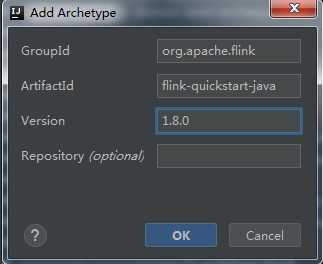标签:命令 这一 开发 程序 thread 微信 job 简单的 oca
最近打算研究研究 Flink,根据官方文档写个 Hello,World。入门还是比较容易的,不需要复杂的安装环境、配置。这篇文章简单介绍 Flink 的使用感受以及入门。
可以看出 Flink 致力于为开发者提供一种方便、易用的编程框架。同时,社区非常注重文档的详细程序以及开发者使用的便利性。
下面的内容是搭建 Flink 环境,并运行 WordCount。
Flink 可以运行在 Linux、Mac OS X 和 Windows 环境。我喜欢在 Windows 下开发,所以在 Windows 运行 Flink。Flink 的最新版本(1.8.0)需要 JDK 的版本为 1.8 以上。本地启动 Flink 非常容易,下载 Flink 二进制包,需要选择 Scala 的版本,如果不用 Scala 开发 Flink 应用程序选哪个版本无所谓。我下载的是 flink-1.8.0-bin-scala_2.11.tgz。启动步骤如下:
cd flink-1.8.0 #解压后的目录 cd bin start-cluster.bat #启动本地 Flink
启动后会发现弹出了两个 Java 程序的窗口。一个是 JobManager,另一个是 TaskManater。通过 http://localhost:8081 访问 Flink 的 web 页面,该站点用于查看运行环境和资源、提交和监控 Flink 作业。
通过简单的 WordCount 感受一下 Flink 应用程序的编写过程。Flink 已经提供生成 Maven 工程的模板
# 使用 Java 的 maven 工程 mvn archetype:generate \ -DarchetypeGroupId=org.apache.flink \ -DarchetypeArtifactId=flink-quickstart-java \ -DarchetypeVersion=1.8.0 # 使用 Scala 的 maven 工程 mvn archetype:generate \ -DarchetypeGroupId=org.apache.flink \ -DarchetypeArtifactId=flink-quickstart-scala \ -DarchetypeVersion=1.8.0
如果不想通过命令行的方式生成 maven 工程,可以通过如下设置在 IDEA 中创建 Flink 应用的模板工程,以 Java 为例

在如上的页面点击 “Add Archetype...”,然后再弹出的对话框填写如下内容

选择我们添加的 archetype 便可继续创建 maven 工程。除了 maven 工程还可以创建 Gradle 和 Sbt 工程。
为了快速运行 Flink 应用,我们可以直接将官网 WordCount 例子的代码拷贝自己的项目。Java 代码如下
import org.apache.flink.api.common.functions.FlatMapFunction; import org.apache.flink.api.common.functions.ReduceFunction; import org.apache.flink.api.java.utils.ParameterTool; import org.apache.flink.streaming.api.datastream.DataStream; import org.apache.flink.streaming.api.environment.StreamExecutionEnvironment; import org.apache.flink.streaming.api.windowing.time.Time; import org.apache.flink.util.Collector; public class FirstCase { public static void main(String[] args) throws Exception { // the port to connect to final int port = 9000; // get the execution environment final StreamExecutionEnvironment env = StreamExecutionEnvironment.getExecutionEnvironment(); // get input data by connecting to the socket DataStream<String> text = env.socketTextStream("192.168.29.132", port, "\n"); // parse the data, group it, window it, and aggregate the counts DataStream<WordWithCount> windowCounts = text .flatMap(new FlatMapFunction<String, WordWithCount>() { @Override public void flatMap(String value, Collector<WordWithCount> out) { for (String word : value.split("\\s")) { out.collect(new WordWithCount(word, 1L)); } } }) .keyBy("word") .timeWindow(Time.seconds(5), Time.seconds(1)) .reduce(new ReduceFunction<WordWithCount>() { @Override public WordWithCount reduce(WordWithCount a, WordWithCount b) { return new WordWithCount(a.word, a.count + b.count); } }); // print the results with a single thread, rather than in parallel windowCounts.print().setParallelism(1); env.execute("Socket Window WordCount"); } // Data type for words with count public static class WordWithCount { public String word; public long count; public WordWithCount() {} public WordWithCount(String word, long count) { this.word = word; this.count = count; } @Override public String toString() { return word + " : " + count; } } }
虽然不太熟悉 Flink 编程模型,但从上面代码中基本上能推测出每一步的含义。由于我们入门 Flink ,刚开始没必要太纠结代码本身。先将 Demo 运行起来,在慢慢深入学习。现在统计程序已经有了,但是还缺少数据源。官网的例子使用的是 netcat ,我在 Windows 下安装了该工具,但是觉得用起来不方便。在 Linux 虚拟机上装了一个,这样用法跟官网一致的。我的虚拟机系统为 Centos 7 64位,安装命令如下
yum install nmap-ncat.x86_64
启动 netcat 用于发数据
nc -l 9000
接下来便是启动 Flink 应用程序连接数据源并进行统计。 启动之前需要将以下代码中 ip 和 端口换成自己的
DataStream<String> text = env.socketTextStream("192.168.29.132", port, "\n");
启动 Flink 应用程序有两种方式,一种是直接直接在 IDEA 中直接运行 Java 程序;另一种是通过 maven 打一个 jar 包,提交到 Flink 集群运行。第二种方式的命令如下
$FLINK_HOME\bin\flink run $APP_HOME\flink-ex-1.0-SNAPSHOT.jar
FLINK_HOME 为 flink 二进制包的目录
APP_HOME 为上面创建的 maven 工程的目录
启动 Flink 应用后,我们可以在 netcat 中输入文本,并观察 Flink 的统计结果
$ nc -l 9000
a a
我们只发送了一行,内容为“a a”。如果在 IDEA 中启动程序可以直接在 IDEA 控制台看到输出结果,如果通过 flink run 方式启动,需要在 TaskManager 的窗口中查看输出。输出内容如下
a : 2 a : 2 a : 2 a : 2 a : 2
为什么输出了 5 次。来看一下我们的应用程序中有这样一句
.timeWindow(Time.seconds(5), Time.seconds(1))
它代表 Flink 应用程序每次处理的数据窗口为 5s,处理完后,整个窗口向前滑动 1s 。也就是每次处理的数据为“最近 5s”的数据。因为最近 5s 数据源中只有“a a”这一条记录,因此输出 5 次。
以上便是 Java 版的 WordCount。当然我们也可以用 Scala 编写,且 Scala 的写法更简洁,代码量更少。
import org.apache.flink.api.java.utils.ParameterTool import org.apache.flink.streaming.api.scala._ import org.apache.flink.streaming.api.windowing.time.Time object SocketWindowWordCount { def main(args: Array[String]) : Unit = { // get the execution environment val env: StreamExecutionEnvironment = StreamExecutionEnvironment.getExecutionEnvironment // get input data by connecting to the socket val text = env.socketTextStream("192.168.29.132", 9000, ‘\n‘) // parse the data, group it, window it, and aggregate the counts val windowCounts = text .flatMap { w => w.split("\\s") } .map { w => WordWithCount(w, 1) } .keyBy("word") .timeWindow(Time.seconds(5), Time.seconds(1)) .sum("count") // print the results with a single thread, rather than in parallel windowCounts.print().setParallelism(1) env.execute("Socket Window WordCount") } // Data type for words with count case class WordWithCount(word: String, count: Long) }
基本上是 Java 一半的代码量。个人感觉 Scala 做大数据统计代码还是挺合适的,虽然 Scala 门槛比较高。Scala 程序的运行方式跟 Java 一样。编写过程中如果出现以下错误,需要看看是不是 import 语句没写对
Error:(29, 16) could not find implicit value for evidence parameter of type org.apache.flink.api.common.typeinfo.TypeInformation[String] .flatMap { w => w.split("\\s") }
解决方法
import org.apache.flink.streaming.api.scala._
以上便是 Flink 的简单入门,后续继续关注 Flink 框架。
欢迎关注公众号「渡码」

标签:命令 这一 开发 程序 thread 微信 job 简单的 oca
原文地址:https://www.cnblogs.com/duma/p/10928055.html